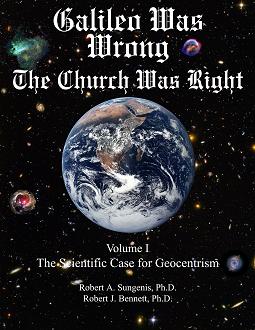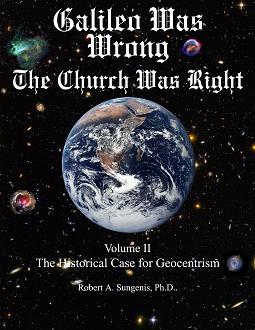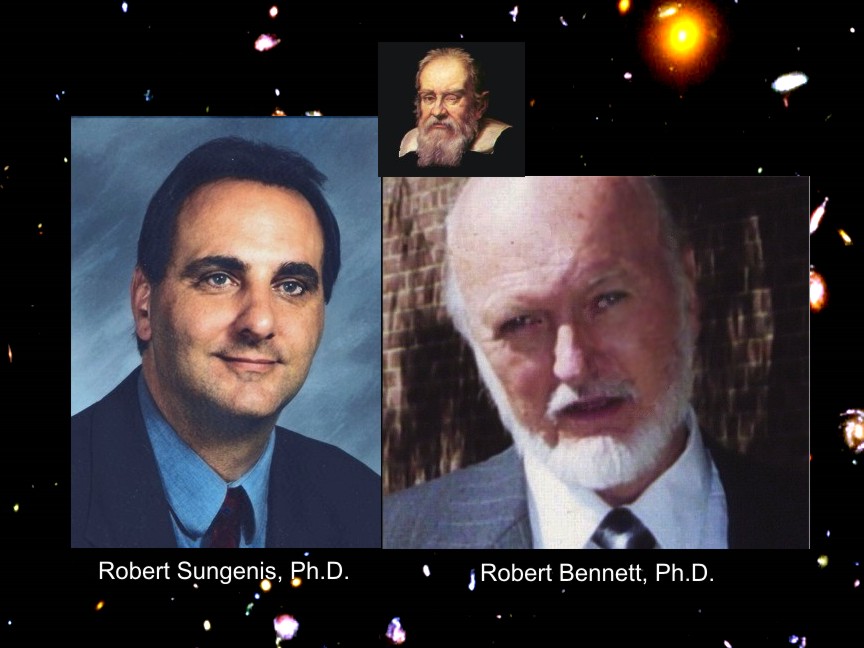|
div id="navlist">
Geocentrism Home Is It Possible? Big Bang Assumptions Observations Geocentrism 101 Galileo Was Wrong Links Contact |
Galileo Was WrongA Two Volume SetBy Robert Sungenis and Robert BennettThe Galileo Was Wrong book is now complete. Currently, there are two volumes available: 1. Galileo Was Wrong, the Church Was Right, Volume I: The Scientific Case for Geocentrism, by Dr. Robert Sungenis and Dr. Robert Bennett. 650 pgs. 2. Galileo Was Wrong, the Church Was Right, Volume II : The Historical Case for Geocentrism, by Dr. Robert Sungenis. 400 pages. The books are available in hardback, downloadable PDF, or on cdrom. The cdrom contains many extras, including animations of the geocentric and heliocentric system, including parallax, retrograde motion, the seasons, Newton's laws of motion, Greek and Indian systems, plus more. Purchase of the hardcover books will include a cdrom. 
Vol. I (the Scientific Evidence) demonstrates through history, philosophy, and mainly through science itself that modern science has not demonstrated that the earth moves or is not in the center of the universe. It demonstrates that in fact observation after observation and experiment after experiment indicate that the earth does not move and is in the center of the universe. Scientist after scientist admit candidly that "it appears that the earth is standing still" or that " we appear to have a priviliged position" (i.e., are at center). Of course science offers complicated explanations as to why every observation indicates that we are at the center and not moving, yet somehow actually we are not at center and are moving. By studying the history of the observations and experiments the authors clearly show that the observations and experimental results, when they present themselves, are rejected out of hand by the scientists, without even considering one of the simplest explanations- THE EARTH IS AT CENTER AND IS NOT MOVING. Rather science becomes more complicated to reconcile the observations with the undemonstrated assertion that the earth is moving and not in the center. Now we must accept that the universe is a 4-dimensional hypercube or doughnut (in order to escape the possibility that we are at center) and that objects (and clocks) shrink in the direction of travel (to escape the interferometric evidence that we are not circling the sun at 30 km/second), etc. 
The second volume contains sections on Scriptural support for geocentrism, the view of the fathers and theologians, and a very large section on the ecclesial case for geocentrism, amongst other things. The second volume is very important. It clears up the statements of the popes, it explains what actually happened in 1822, it explains what John Paul II actually said in 1992, and much more, incuding the true extent of what occured at the Galileo trial. Volume II conclusively shows that the Church did support geocentrism solidly through at least 1833, then to some degree became ambivalent to it without reversing its earlier decrees. Volume II also presents the Scriptural and patristic consensus for geocentrsim, the basis of the action of the popes. Both these books are a "must read " for serious students of truth. This topic challenges a basic consensus in our current world. Very few in the centuries since Galileo have taken the time, and done the research to present the case for geocentrism. Almost all commentators start with the presumption that the earth moves, then attempt to reconcile the evidence to the presumption. All who read Galileo Was Wrong will be pleasantly suprised at what occurs when a researcher is open to the possibity of geocentrism. Things become more sraight forward and simple. There is no need to deconstruct Urban VIII's intent (i.e., he was insulted by Galileo), no need to read a condemnation of geoecentrism into John Paul II's 1992 speech (where none was stated). There is no need to ignore the fact that most observations place us in the center and not moving, then try to create more complex scientific theories to reconcile the observations with theory (i.e., making matter shrink, time contract, space warp, etc.).
|

